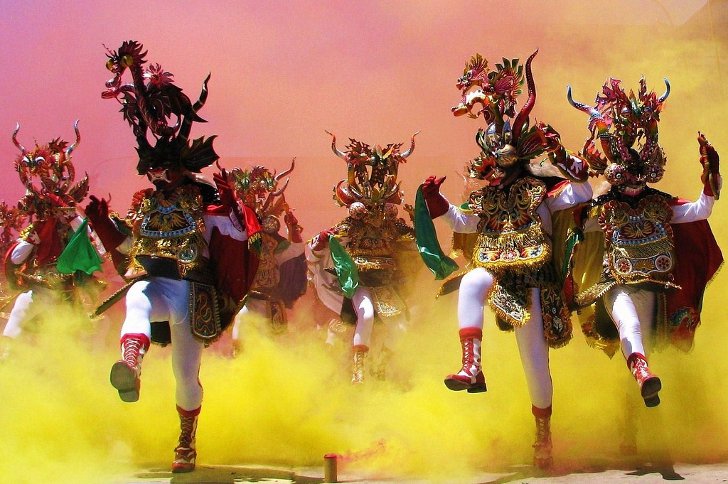Before Spanish colonization the area that is now Oruro was a religious pilgrimage site because indigenous peoples of the Andes believed it was home to protective deities. After the Inca Empire took over the region, an evil demigod and a sacred demigod were added to the pantheon by the Incas who tried to introduce their religion. Subsequent Spanish colonization of the Americas lead to a unique religious syncretism of Christianity and local religious beliefs. That’s why modern Bolivian Carnival is a blend of Catholic and pagan customs.
Oruro is known for its flourishing mining industry. That’s why its Carnival is dedicated to the city’s patron Virgen del Socavón (Our Lady of the Tunnels or Our Lady of the Mineshaft). She is venerated as the patron saint of the miners.
The Oruro Carnival in honor of the Virgen del Socavón typically begins on the last Saturday before Lent. It’s a non-stop three-day celebration filled with dancing, singing, music, processions, and parties. The festivities last from early morning until late at night, 18 hours a day. Revelers dress up as angels, devils, demons, Incas, and Spanish conquistadors.
On Carnival Saturday about 50 folk groups specializing in different folk dances and 150 bands participate in a pilgrimage to the sanctuary of the Virgen del Socavón. The procession includes over 28,000 dancers and approximately 10,000 musicians. The pilgrimage is followed by the enactment of two medieval-style mystery plays. Carnival Sunday features a marching band competition.
The main highlight of the Carnival of Oruro is the Diablada also known as Dance de Diablos (Dance of the Devils). It’s a traditional Andean masked dance performed by dancers wearing devil masks and costumes. Like the Oruro Carnival in general, the Diablada is a mixture of Andean religious ceremonies and Spanish theatrical performances. The dance has three versions of choreography. Other dances performed during the Carnival include morenada, tobas, tinku and caporales.
The Carnival of Oruro is truly unique because it is one of the few Carnivals that incorporate pre-Columbian customs. No wonder UNESCO proclaimed it one of the Masterpieces of the Oral and Intangible Heritage of Humanity in 2001.

Photo: Ivan Milo




